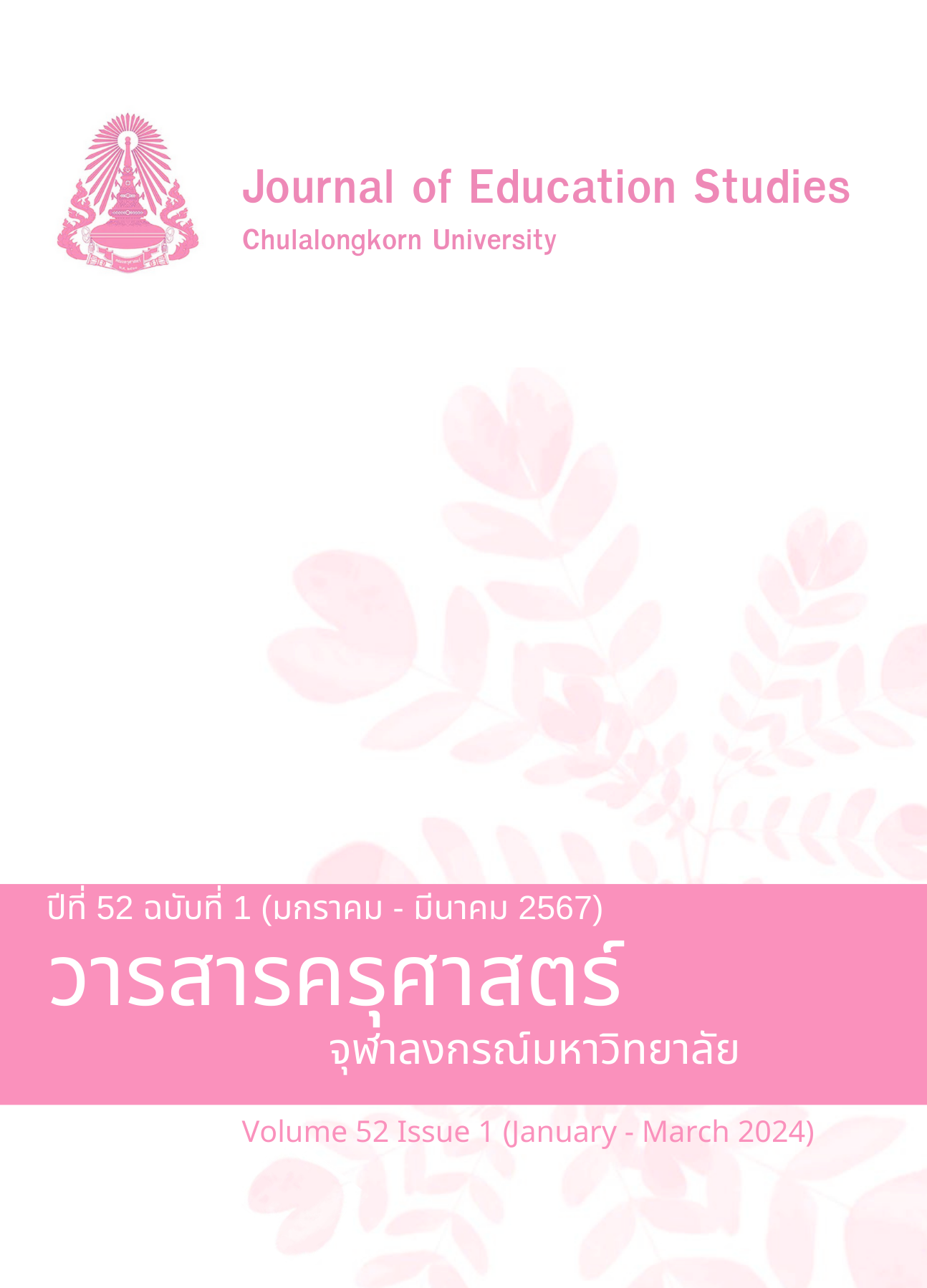Online Student-Centered Learning and Assessment During the COVID-19 Pandemic Through Perspectives of Higher Education Teachers and Students
DOI:
https://doi.org/10.14456/educu.2024.11Keywords:
Online Learning, Online Learning Assessment, Learner-Centered LearningAbstract
This study aimed to 1) analyze student-centered learning and assessment of higher education teachers and students during the COVID-19 pandemic as well as their ability to meet learning objectives, and 2) compare the online learning efficiency of students with four psychological attributes, consisting of student-teacher engagement, online learning characteristics, self-directed learning, and self-assessment. The sample included 1,409 university students and 274 teachers. The research instrument was a student-centered online learning and assessment scale. Data were analyzed via descriptive statistics and a chi-squared test. The results revealed that the sample struggled with unstable Internet or WIFI connection, a lack of technological devices, and ineffective performance in learning. While students perceived themselves as being able to self-learn, teachers primarily used lectures on online platforms. Along with attendance, students perceived that teacher used testing for assessment, while teachers used task assignments. Compared to a traditional classroom, students also believed that their knowledge and skills acquired through online learning were lower, while their attribute was maintained. Students with a high level of the four psychological attributes indicated a better perception of online learning efficiency at the .05 level of significance.
References
ภาษาไทย
ชุติวัฒน์ สุวัตถิพงศ์ เเละ อุบล ทองปัญญา. (2563). การใช้เทคโนโลยีดิจิทัลเพื่อส่งเสริมการเรียนรู้เชิงรุก. วารสารเทคโนโลยีเเละสื่อสารการศึกษา. วารสารเทคโนโลยีและสื่อสารทางการศึกษา, 15(18), 23-33. https://so01.tci-thaijo.org/index.php/ectstou/article/view/224124
ทิพอาภา กลิ่นคำหอม. (2556). โมเดลเชิงสาเหตุของความยึดมั่นผูกพันของนักเรียนและผลสัมฤทธิ์ทางการเรียนที่เกิดจากอิทธิพลของครู [วิทยานิพนธ์ปริญญามหาบัณฑิต]. Chulalongkorn University Intellectual Repository (CUIR). http://doi.org/10.14457/CU.the.2013.646
สุมน อมรวิวัฒน์. (2541). การปฏิรูปการเรียนรู้ตามแนวคิด 5 ทฤษฎี. สำนักงานคณะกรรมการการศึกษาแห่งชาติ สำนักนายกรัฐมนตรี.
สำนักงานคณะกรรมการการศึกษาแห่งชาติ. (2545). พระราชบัญญัติการศึกษาแห่งชาติ พ.ศ. 2542 และที่แก้ไขเพิ่มเติม (ฉบับที่ 2) พ.ศ. 2545. สำนักงานคณะกรรมการการศึกษาแห่งชาติ.
อักษร เอ็ดดูเคชั่น. (2566, 23 กันยายน). Part1/4 | อบรมหลักสูตรการจัดการเรียนรู้ Active Learning สู่สมรรถนะให้มีประสิทธิภาพ [Video]. YouTube. https://www.youtube.com/watch?v=kpVNYvA-K7g
ภาษาอังกฤษ
Abou-Khalil, V., Helou, S., Khalife, E., Chen, M. A., Majumdar, R. & Ogata, H. (2021). Emergency online learning in low-resource settings: effective student engagement strategies. Education Sciences, 11(1), 24.
Ali, W. (2020). Online and remote learning in higher education institutes: a necessity in light of COVID-19 pandemic. Higher Education Studies, 10(3), 16-25.
ASEAN University Network. (2020). ASEAN University Network Quality Assurance: guide to AUN-QA assessment at programme level version 4.0. ASEAN University Network.
Baticulon, R. E., Sy, J. J., Alberto, N. R. I., Baron, M. B. C., Mabulay, R. E. C., Rizada, L. G. T., Tiu, C. J S., Clarion, C. A. & Reyes, J. C. B. (2021). Barriers to online learning in the time of COVID-19: a national survey of medical students in the Philippines. Medical Science Educator.
Collard, P., Nemeth, S., Vince, D. & Kaderjak, A. (2016). Creating creative learning environments by creative partnerships programme—evaluation of the creative partnerships pilot mathematics programme in pécs. Creative Education, 7(5), 741-767.
Crawford, J., Butler-Henderson, K., Rudolph, J., Malkawi, B., Glowatz, B., Burton, R., Magni, P. A. & Lam, S. (2020). COVID-19: 20 countries' higher education intra-period digital pedagogy responses. Journal of Applied Learning & Teaching, 3(1). 9-28.
Creativity, Culture and Education. (2012). Changing young lives. CCE.
Dhawan, S. (2020). Online learning: A panacea in the time of COVID-19 crisis. Journal of Educational Technology Systems, 49(1), 5-22.
Durnali, M. (2020). The effect of self-directed learning on the relationship between self-leadership and online learning among university students in Turkey. Tuning Journal for Higher Education, 8(1), 129-65.
Ferketich, S. (1991). Focus on psychometrics aspects of item analysis. Research in Nursing & Health, 14(2), 165-168.
Francis, H. (2017). The role of technology in self-directed learning: a literature review. ACS Center for Inspiring Minds.
Gliem, J. A. & Gliem, R. R. (2003). Calculating, interpreting, and reporting Cronbach’s alpha reliability coefficient for Likert-type scales. http://hdl.handle.net/1805/344
Gossling, N. (2019). Impacting student learning outcomes by addressing basic needs of students and their families. https://nwcommons.nwciowa.edu/education_masters/156
Hodges, C., Moore, S., Lockee, B., Trust, T. & Bond, A. (2020, March 27). The difference between emergency remote teaching and online learning. https://er.educause.edu/articles/2020/3/the-difference-between-emergency-remote-teaching-and-online-learning
Hung, M. L., Chou, C., Chen, C. H., & Own, Z. Y. (2010). Learner readiness for online learning: Scale development and student perceptions. Computers & Education, 55(3), 1080-1090.
Joosten, T. & Cusatis, R. (2020). Online learning readiness. American Journal of Distance Education, 34(3), 180-193.
Knowles, M. S. (1975). Self-directed learning: a guide for learners and teachers. Association Press.
Krejcie, R. V. & Morgan, D. W. (1970). Determining sample size for research activities. Educational and Psychological Measurement, 30, 607-610.
Marinoni, G., Van’t Land, H., & Jensen, T. (2020). The impact of COVID-19 on higher education around the world. IAU Global Survey Report.
Martin, F. & Bolliger, D. U. (2018). Engagement matters: student perceptions on the importance of engagement strategies in the online learning environment.
Online Learning, 22(1), 205-222.
McGuire, C. J. & Castle, S. (2010). An analysis of student self-assessment of online, blended, and face-to-face learning environments: implications for sustainable education delivery. American Journal of Education, 3(3), 36-40.
Moore, M. G. (1989). Three types of interaction. Taylor & Francis.
Mukhtar, K., Javed, K., Arooj, M. & Sethi, A. (2020). Advantages, limitations and recommendations for online learning during COVID-19 pandemic era. Pakistan Journal of Medical Sciences, 36(COVID19-S4), 27-31.
North Carolina Community College System. (n.d.). Online readiness assessment. https://vlc.nccommunitycolleges.edu/faculty/online-readiness-checklist/
Penn State University. (n.d.). Online learning readiness questionnaire. http://tutorials.istudy.psu.edu/learningonline/ORQ/ORQ.htm
Spencer, E., Lucas, B., & Claxton, G. (2012). Progression in creativity: developing new forms of assessment. CCE.
Yamane, T. (1967). Statistics, an introductory analysis (2nd ed.). Harper and Row.
Yan, Z & Brown, G. T. L. (2017). A cyclical self-assessment process: towards a model of how students engage in self-assessment. Assessment & Evaluation in Higher Education, 42(8), 1247-1262.
Yan, Z. (2018). The self-assessment practice scale (saps) for students: development and psychometric studies. The Asia-Pacific Education Researcher, 27(2). 123-135.
Yang, H., Su, J. & Bradley, K. D. (2020). Applying the Rasch model to evaluate the self-directed online learning scale (SDOLS) for graduate students. International Review of Research in Open and Distributed Learning, 21(3), 99-120.
Downloads
Published
How to Cite
Issue
Section
License

This work is licensed under a Creative Commons Attribution-NonCommercial-NoDerivatives 4.0 International License.




